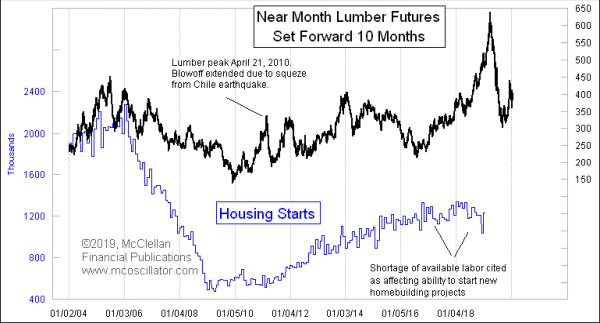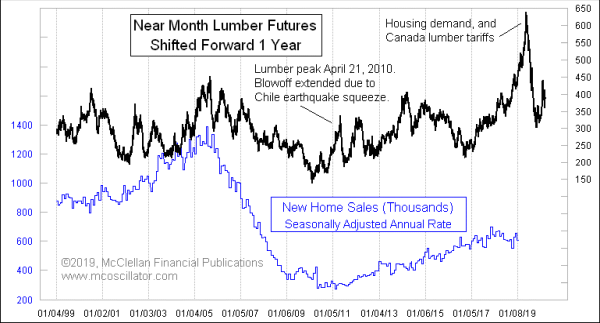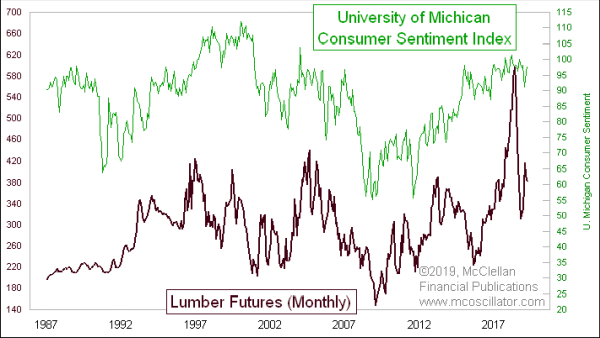
For years, the price of lumber futures has been a pretty good leading indicator for a variety of economic data, especially the series related to the housing market. But recent events have caused lumber to not be a good leading indicator. It is likely just temporary, and hopefully lumber will get back to being a good messenger about what the future holds. So we should not expect the data on U.S. housing starts in this week’s chart to echo lumber’s big blowoff top.
Housing starts data usually follow the dance steps of lumber prices with about a 10-month lag. This is some of the magic of what lumber prices used to be able to reveal. The lumber futures market had an ability to sniff out future trends in the economy ahead of time and reveal those in its movements. But when exogenous events like the 2010 earthquake in Chile put a thumb on the scale of lumber prices, then the message from those prices is not as useful.
In April 2017, the U.S. imposed a tariff on Canadian softwood lumber of 20-25% (depending on the location of the Canadian producer), in response to subsidies granted to the lumber industry by the Canadian national government as well as provincial governments. That followed the October 2015 expiration of the U.S.-Canada Softwood Lumber Agreement, as well as the expiration of a 1-year moratorium on trade actions following that expiration. Despite efforts from Canadian and U.S. trade representatives to reach a new deal, no new agreement has been achieved. Canada has claimed that the tariffs violate the terms of NAFTA, and has escalated the complaint to the WTO, but that body has not yet ruled.
The imposition of those tariffs set off a big squeeze in the lumber markets across the U.S., as major consumers of lumber such as homebuilding firms scrambled to lock in sources for the 2x4s and other sizes that they needed for their upcoming projects. And they sought to lock in pricing in the futures market, causing a classic blowoff which drove up prices far more than the amounts of the tariffs. That caused lumber futures prices to nearly double from the moment when the tariffs were imposed.
And like any blowoff top, there had to be a corresponding collapse just to satisfy nature and balance things out. All of this constituted the same sort of exogenous event as the 2010 Chile earthquake, but on a much grander scale. And it makes the last 2 years’ price action in lumber worthless as a leading indication.
The whole point of the leading indication is to get messages about the future state of the economy based on what economic forces are doing to lumber prices. But when prices are not moving based on those economic forces, but rather based on exogenous events, it’s like shooting the messenger.
Lumber prices typically also lead new home sales by about a year: One of the most interesting correlations of all is how lumber prices move in step with consumer sentiment, at least most of the time. Here is a comparison between lumber futures and the University of Michigan’s Consumer Sentiment Index:
One of the most interesting correlations of all is how lumber prices move in step with consumer sentiment, at least most of the time. Here is a comparison between lumber futures and the University of Michigan’s Consumer Sentiment Index:
As with the other relationships to lumber prices, this one had been wonderful right up until the big blowoff. There is no way that consumer sentiment can see the same degree of excess, and so it does not. Nor does sentiment feel the big collapse that lumber prices have displayed. It is best to just put your thumb over that part of the chart.
My estimation is that, for about the next year or so, lumber’s economic message is effectively worthless. It is very much like how the surf forecast for Southern California beaches is normally very reliable, except on the day when the asteroid falls into the ocean. Eventually the waves will return to normal, and answer to the forces of wind and tide, but the tsunami has to get done first.
The magnitude of the lumber futures market blowoff even becomes evident when we compare it to what timber prices were doing. As an aside, “timber” refers to the raw logs, either standing in a forest of just freshly cut. To turn timber into finished lumber, you have to add cost factors for transportation, labor, fuel, electricity and capital costs. Here is a comparison of lumber prices to western Washington timber prices:
The two plots usually move in lock-step, which is as one would expect. Higher lumber prices mean that mills are willing to pay more to buy logs. But things got interesting in the spring of 2018. Timber prices peaked in February 2018, and lumber made an initial peak in step with that timber price peak. But then, lumber futures swooped up another 23% to an even higher blowoff peak, while timber prices were declining. It was the timber market’s way of saying, “Nahhh, we ain’t buying this blowoff.”
Now the two are getting back in sync again, or so it seems, which gives us hope that eventually the lumber futures market is going to be a legitimate indicator for the economy again. But until we see evidence that things are back to normal again, lumber cannot be considered a reliable economic indicator.
Tom McClellan,
Editor
The McClellan Market Report
www.mcoscillator.com
